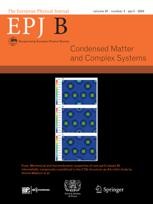New insights into the early stages of creep deformation
Computer simulations show that the evolution of material structures during creep deformation can modify material properties
New York | Heidelberg, 30 July 2019
 The properties of many materials can change permanently when they are pushed beyond their limits. When a given material is subjected to a force, or ‘load’, which is stronger than a certain limit, it can become so deformed that it won’t return to its original shape, even after the load is removed. However, heavy loads aren’t strictly necessary to deform materials irreversibly; this can also occur if they are subjected to lighter loads over long periods of time, allowing a slow process called ‘creep’ to take place. Physicists have understood for some time that this behaviour involves sequences of small, sudden deformations, but until now, they have lacked a full understanding of how creep deformation affects material properties over time. In new research published in EPJ B, Michael Zaiser and David Castellanos at the University of Erlangen-Nuremberg in Germany analysed the characteristic ways in which material structures evolve during the early stages of creep deformation.
The properties of many materials can change permanently when they are pushed beyond their limits. When a given material is subjected to a force, or ‘load’, which is stronger than a certain limit, it can become so deformed that it won’t return to its original shape, even after the load is removed. However, heavy loads aren’t strictly necessary to deform materials irreversibly; this can also occur if they are subjected to lighter loads over long periods of time, allowing a slow process called ‘creep’ to take place. Physicists have understood for some time that this behaviour involves sequences of small, sudden deformations, but until now, they have lacked a full understanding of how creep deformation affects material properties over time. In new research published in EPJ B, Michael Zaiser and David Castellanos at the University of Erlangen-Nuremberg in Germany analysed the characteristic ways in which material structures evolve during the early stages of creep deformation.
Using computer simulations, the researchers show that this evolution not only modifies material properties; it can also alter the parameters of those properties, meaning the chances of certain events occurring within the material will change. Their work offers physicists important new insights into the long-term behaviours of a wide variety of structural materials under stress, including rocks, porous materials and glass. As well as observing these changes, Zaiser and Castellanos also studied patterns in intervals between deformation events. They found that the events strongly conform to Omori law, which is used by seismologists to calculate time intervals between aftershocks following earthquakes of certain magnitudes.
The duo made their discoveries using computer simulations which modelled creep deformation as a sequence of discrete, randomly activated events. Through their innovative modelling approach, Zaiser and Castellanos have now gathered important insights into how the properties of materials subjected to lighter loads will change over time in the long term.
References: D.F. Castellanos, M. Zaiser (2019), Statistical dynamics of early creep stages in disordered materials, European Physical Journal B 92:139, DOI: 10.1140/epjb/e2019-100124-0
Further Information
For more information visit: www.epj.org
Services for Journalists
The full-text article is available here.
Contact
Sabine Lehr | Springer | Physics Editorial Department
tel +49-6221-487-8336 | sabine.lehr@springer.com
